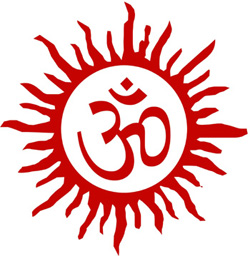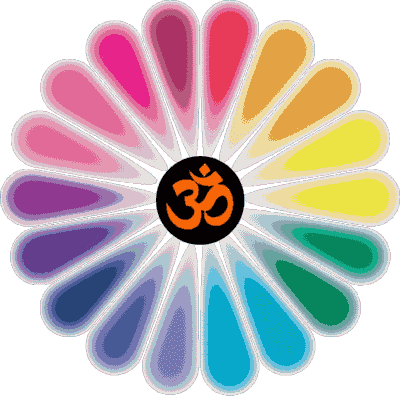VASTU SHASTRA
Om (Aum)

The ancient syllable "OM" is the shortest of the Mantras and in Indian tradition it is a word suggestive of God.
The scriptures tell us that "OM" is the planets primordial vibration from which the entire universe has arisen. All other sounds are contained within it.
It is believed that "OM" is the mother of all languages. Repetition of "OM" enables us to maintain mental and emotional calmness, overcome obstacles and enable understanding.
An analysis of "OM" as it is written in Sanskrit shows that it is made up of A, U, M and a symbol representing resonance. So "OM" has four aspects.
The first is A, a sound that comes from the belly, is formed in the open throat, and is voiced with the mouth open. As with many alphabets, A is the first letter of the Sanskrit alphabet.
The second aspect is the U, a sound that is formed in the middle of the mouth. The mouth is not as wide as it is for sounding the A.
With the third sound, M the mouth closes. The sound rises to the nasal passages, from where the resonance, the forth aspect of "OM" issues forth.
It is said that A represents the waking state. U the dream state and M the state of deep dreamless sleep. the fourth state, sounds in the resonance following M.
Saying "OM" is actually a form of meditation
Om or Aum is of paramount importance in Hinduism. This symbol (as seen in the image on the right) is a sacred syllable representing Brahman, the impersonal Absolute of Hinduism — omnipotent, omnipresent, and the source of all manifest existence. Brahman, in itself, is incomprehensible; so a symbol becomes mandatory to help us realize the Unknowable. Om, therefore, represents both the unmanifest (nirguna) and manifest (saguna) aspects of God. That is why it is called pranava, to mean that it pervades life and runs through our prana or breath.

Om in Daily Life
Although Om symbolizes the most profound concepts of Hindu belief, it is in use daily. The Hindus begin their day or any work or a journey by uttering Om. The sacred symbol is often found at the head of letters, at the beginning of examination papers and so on. Many Hindus, as an expression of spiritual perfection, wear the sign of Om as a pendant. This symbol is enshrined in every Hindu temple premise or in some form or another on family shrines.
It is interesting to note that a newly born child is ushered into the world with this holy sign. After birth, the child is ritually cleansed and the sacred syllable Om is written on its tongue with honey. Thus right at the time of birth the syllable Om is initiated into the life of a Hindu and ever remains with him as the symbol of piety. Om is also a popular symbol used in contemporary body art and tattoos.
The Eternal Syllable
According to the Mandukya Upanishad, "Om is the one eternal syllable of which all that exists is but the development. The past, the present, and the future are all included in this one sound, and all that exists beyond the three forms of time is also implied in it".
The Music of Om
Om is not a word but rather an intonation, which, like music, transcends the barriers of age, race, culture and even species. It is made up of three Sanskrit letters, aa, au and ma which, when combined together, make the sound Aum or Om. It is believed to be the basic sound of the world and to contain all other sounds. It is a mantra or prayer in itself. If repeated with the correct intonation, it can resonate throughout the body so that the sound penetrates to the centre of one's being, the atman or soul.
There is harmony, peace and bliss in this simple but deeply philosophical sound. By vibrating the sacred syllable Om, the supreme combination of letters, if one thinks of the Ultimate Personality of Godhead and quits his body, he will certainly reach the highest state of "stateless" eternity, states the Bhagavad Gita.
The Vision of Om
Om provides a dualistic viewpoint. On one hand, it projects the mind beyond the immediate to what is abstract and inexpressible. On the other hand, it makes the absolute more tangible and comprehensive. It encompasses all potentialities and possibilities; it is everything that was, is, or can yet be. It is omnipotent and likewise remains undefined.
The Power of Om
During meditation, when we chant Om, we create within ourselves a vibration that attunes sympathy with the cosmic vibration and we start thinking universally. The momentary silence between each chant becomes palpable. Mind moves between the opposites of sound and silence until, at last, it ceases the sound. In the silence, the single thought Om is quenched; there is no thought. This is the state of trance, where the mind and the intellect are transcended as the individual self merges with the Infinite Self in the pious moment of realization. It is a moment when the petty worldly affairs are lost in the desire for the universal. Such is the immeasurable power of Om.
Er. Rameshwar Prasad invites you to the Wonderful World of Vastu Shastra
Engineer Rameshwar Prasad(B.Tech., M.Tech., P.G.D.C.A., P.G.D.M.) Vaastu International
|

